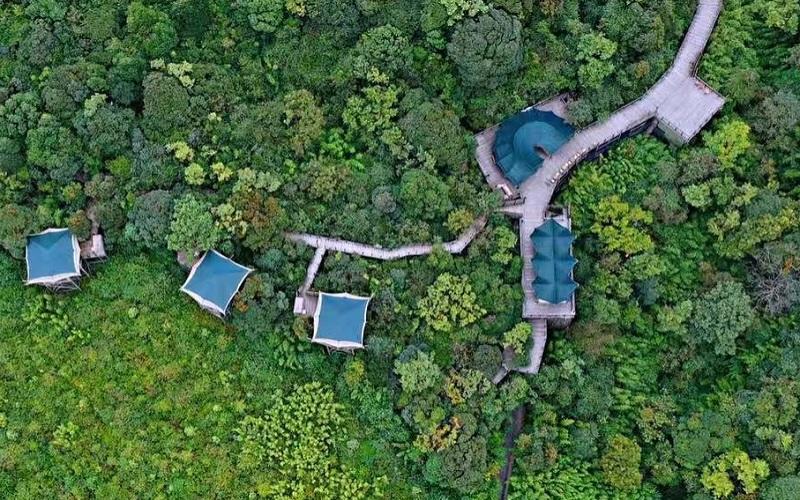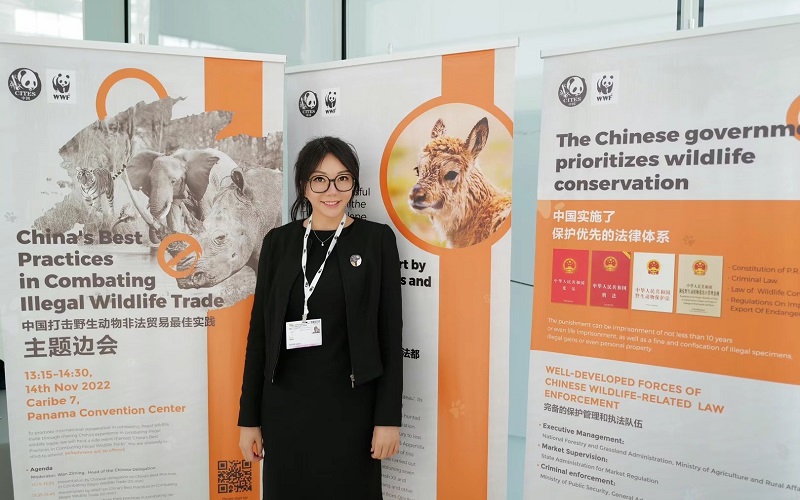Koko Tang






Koko Tang - If you're interested in sustainable tourism and its impact on the world, you'll want to hear about this trailblazing Chinese entrepreneur.
Koko is the founder of Colorful Earth, Co-Founder of Vinetree Tourism and sits on the board of the Global Sustainable Tourism Council. She is the ESG Director of Fudan University's Institute of Commerce, Civilization, Commons, a tourism expert consultant of the Shanghai Chongming Government ThinkTank, and a certified hotel administrator.
Passionate About Travel and New Cultures
Koko has always had a passion for travel and experiencing new cultures. She studied law and worked for a well-known international law firm for over seven years before realizing that her true calling was in the tourism industry. Koko was born in Yunnan, China, a beautiful and popular tourist destination with 26 ethnic groups and diverse landscapes, attracting over 500 million travelers annually.
Aiming for Sustainable Tourism Practices
Koko realized that not all locals were happy with the influx of tourists into their hometown. This realization prompted her to co-found Vinetree in 2015, a local tourism company that focuses on sustainable tourism practices. Vinetree is one of the few early adopters of ecotourism principles in China, and it was the first high-end boutique tented resort in the country.
The first project, Vinetree Geladan Tented Resort, was built on top of Laojun Mountain at 3680 meters above sea level and only had seven guest rooms. The original idea was to limit the carrying capacity to the extent that it would not harm the surrounding nature and community.
Integrating Sustainable Tourism Standards
As co-founder, Koko has led the company to rebuild its brand and integrate sustainable tourism standards into all decision-making processes, from investment to design to operation and administration. In 2016, Vinetree joined the Global Sustainable Tourism Council (GSTC) as the first Chinese tourism accommodation company to do so.
Vinetree: Celebrating Authenticity, Localization and Sustainability
One of the unique features of Vinetree is its authenticity, localization, sustainability-driven principles, and the experience it provides to guests. The company uses tents as accommodation, which has the lowest carbon footprint of constructions.
Vinetree plans and creates a camp by exploring the authentic experience it can offer to guests. It does not aim to attract people because of outstanding facilities; instead, it wants to attract visitors who are interested in the destination itself and respect the value that Vinetree brings to the destination: authenticity and sustainability.
As a small local tourism company, Vinetree carefully designs and decides on the maximum number of guests it can host at one time by analyzing the carrying capacity of the destination itself, based on science. The company doesn't want the destination to be overwhelmed or overly exploited.
Sustainability in Practice
Since sustainability has been in Vinetree's DNA since day one, choosing the site, designing and building the camp, and operating it have all been focused on sustainability. Initially, focusing on sustainable tourism meant more cost, as Vinetree spent more time and money on assessments and choosing the least impactful location for the campsite.
For example, at the Vinetree Gaoligong Tented Resort, the company spent over RMB 10 million to build an elevated walkway and put the tents on top of it. This design allowed all pipework to be hidden underneath the walkway, eliminating the need to dig trenches and dramatically reducing the scale and environmental impact of construction. The walkway also effectively separates human activities from wildlife, and all trekking is guided by trained staff to ensure the safety of both guests and nature.
Areas of expertise:
Koko Tang: Championing Sustainable Tourism Entrepreneurship in China
Koko, do you remember what first got you interested in tourism and sustainable development? Who or what inspired you?
I studied law and got my training in a well-known international law firm for over 7 years. I was responsible for cross-border transactions, M&A projects. It seems like a total shift of career. But no matter what I do, travel was always in my DNA. I spent every annual leave I could take to travel to different places.
I am so attracted to the diversity of the world, the landscaping, the people, and the culture. When I visit a place, I prefer to live like a local, meet locals, visit the places that locals often do. As a traveler, I would be very happy if I am welcomed by the locals.
But when I was making friends with locals, I realized that not all locals are happy with the tourists. I visited some very famous destinations. Many locals are moving away from their homes to stay away from the touristy areas. Many complained about the traffic congestion, rising rental cost, and trash on the street. They believe it was mainly due to the tourists coming into the town.
Many locals have very complex attitudes towards the tourists. They are happy that their hometown is popular in general, tourism will also bring business and job opportunities to the region. However, at the same time, they don’t like the overcrowded city.
I was born in Yunnan, a beautiful and also touristy destination of China. My hometown has 26 ethic groups living in the same region, it has snow mountains and rainforest. The diversity of wildlife, landscaping, culture, food, and even people is so amazing, attracting over 500 million travelers every year. While there are many more places and things that can be shown to the travelers, I also hope that tourism will only do good to my hometown.
That’s the reason why I joined Vinetree as the Co-founder and CEO in 2015. And started my journey with sustainable tourism.
What is special or outstanding about Vinetree?
I joined Vinetree in 2015. But the company was firstly founded in 2009, 6 years before I joined. The reason I decided to join is that I was truly moved by the concept that Vinetree’s founding team has created. Vinetree is one of the very few early adopters of ecotourism principles in China. It is also the very first high-end boutique tented resort of China.
The first project is called Vinetree Geladan Tented Resort, which was built on top of the Laojun mountain, about 3680 meters above the sea level. It only has 7 guest rooms, the original idea is to limit the carrying capacity to the extent it will not do any harm to the surrounding nature and community. It is exactly what I was hoping to achieve.
After I joined Vinetree, I led the company to rebuild the brand, and to integrate sustainable tourism standards into all decision-making processes, from investment, to design, to operations, and to admin.
In 2016, Vinetree joined GSTC, as the first Chinese tourism accommodation company to do so.
Then we built another two tented resorts in Yunnan, by the rice terrace of Honghe Hani UNESCO World Heritage Site, and in the forest of Gaoligong Mountain, the most biodiversity rich region of the world. At both sites, we strictly follow the GSTC industry criteria.
Vinetree is a small local tourism company. The uniqueness of Vinetree is also because of its authenticity, localization, sustainability-driven and the experience we want to create to the guests.
We use tents as accommodation, which is the lowest carbon footprint construction manner, and the way we plan and create a camp is to explore the authentic experience we can offer to the guests. To put it differently, we don’t aim to attract people because of our outstanding facilities, we want to attract visitors who are interested in the destination itself, but also respect the value we want to bring to the destination – authenticity and sustainability.
Vinetree is small, we carefully design and decide the number of guests we can host maximum at one time, through analyzing the carrying capacity of the destination itself based on science. We don’t want the destination to be packed, overwhelmed and overly exploited.
Sustainability, since day one, is in our DNA, when we choose site, design and build the camp, as well as operation.
How did the focus on sustainable tourism impact Vinetree?
At the very beginning, it meant more cost. We spent more time (which means money) to do assessment, to choose the location of the camp site that will make the least negative impacts. At the Vinetree Gaoligong Tented Resort, we spent over RMB10 million to build an elevated walkway, and put the tents on top of the walkway. The reasons we choose such design are as follows:
All pipework can be hidden underneath the walkway, obviating the need to dig trenches and dramatically reducing the scale and environmental impact of construction.
The walkway effectively separates human activities from wildlife: guests are constrained to the walkway, from which they can observe the wildlife, which remains undisturbed from their activities. All trekking is guided by trained staff to ensure the safety of both the guests and nature.
It is just one of the examples that how we consider the local environment when building the camp. It obviously, will increase costs. However, we are also benefited by integrating GSTC sustainable tourism industry criteria into our decision-making process. We caught a lot of attention from the market. We are recognized by the guests who are looking for authentic experiences in Yunnan while caring about travel in a responsible manner. The number of options available in China is still limited. Many guests, including corporate guests turned to us because we have been taking care of the site carefully. We have been given many awards, and also become one of the sustainable escapes of Lonely Planet right before pandemic. In addition, because we have localized our sourcing channel, it also brings us reduced costs, and better relationship with the community, which is very important, especially for boutique tourism destinations like us.
You have made such an achievement with Vinetree, how come you came up with the idea of Colorful Earth?
What I have learnt from GSTC and from Vinetree, is definitely helping me and my business. I realize that it should not only benefit me myself, but the others. There are a lot of misconceptions that need to be corrected. The market demands more science-based transitional solutions for every single industry, not only for tourism.
For example, when people talk about environment protection, they refer to “green”. But the world has many colors. When we talk about sustainable transition, people often only care about climate change, which is very important, but sustainability is far more than that. Not to mention people believing that planting trees is all good because it brings green. But in fact, the key is to plant the right trees at the right place for the right purpose.
Therefore, in 2022, along with several other true believers and partners, I founded Colorful Earth to promote two things – color of people and color of nature. I believe if there were only one color of the world, it would be colorful.
Colorful Earth is meant to be a social enterprise raising public awareness, focusing on issues relating to biodiversity conservation and diversity, equity and inclusion. It has a wider scope than the tourism sector itself, but tourism will be one of the important sectors where we want to make impacts.
What have Colorful Earth been working on? How are things working out with all the projects?
As mentioned earlier, we have two major topics to address – biodiversity conservation and DE&I. On the biodiversity side, we initiated Pollinator Protectors Alliance in China in December 2022 with more than 40 businesses in China.
A lot of people may not realize that pollinators such as bees, butterflies, beetles actually provide one third of the food we have every day. Pollinators help carry pollen from the male part of the flower to the female part of the same – or another – flower. The movement of pollen must occur for the plant to become fertilized and to produce fruits, seeds, and plants. Therefore, without the pollinators we simply cannot survive.
Unfortunately, we see a dramatic shrink of populations of pollinators, due to many reasons – loss of habitat, climate change, use of pesticides and chemicals, invasive species, diseases. As a matter of fact, almost 40% of the pollinators have already disappeared. We cannot afford losing them. But because they are very small, they are often ignored by people.
PPA was created to raise public awareness, to help the industry, especially agriculture and other relevant industries, to transit into a pollinator friendly manner. The urban landscaping and management shall be pollinator friendly too. We invited architects to design insect hotels for the nature, and to donate those insect hotels to farms and parks. We also train farmers and teach kids about why pollinators are important and what we can do to help protect them.
On the DE&I side, we plan to work on disability inclusion with Valuable 500, a global business collective made up of 500 CEOs and their companies. China is home to the largest population of people with disabilities. There are currently around 85 million people with disabilities living in China. It is very important to address their rights in the society. Accessibility and inclusion are one of the very important factors for a society to become sustainable.
How are you addressing the complexity of specialized knowledge in biodiversity conservation and DE&I?
Sustainability issues are often described to be too complex for people to understand. The many different terminologies scare people away from even starting to look at the meaning itself.
For example, when we talk about biodiversity, maybe the best term is to use “Nature”. Not many people understand the meaning of biodiversity, but if you talk about nature, people would have a general picture about the mountain, water, wind, flowers, plants, birds, wildlife, etc.
I think the very important thing to ensure successful biodiversity or DE&I projects, is to make complexity simpler, to communicate well. It can be achieved in many different ways. Maybe to use another easy language to explain, or to issue toolkits, guidance to explain the meaning, or maybe use some other meanings to help address the issue.
Taking PPA as an example, to emphasize the importance of the pollinators, instead of talking about the numbers and the pollinators, we could say what fruits, food will vanish if we don’t do anything about it. How much the coffee would cost, if we lose pollinators. By having fun, and integrate art, and beauty into the projects, we could draw the public’s attention on pollinator protection.
As a social enterprise, which have been the main challenges Colorful Earth has met so far?
Sustainability is a very big topic. It covers so many issues, industries, and even metrics. It needs to be measured, it needs science and technologies, and it also requires expertise and experiences. In this area, no one is expert. Joint efforts from all stakeholders are necessary. Colorful Earth is a small and young social enterprise, just like pollinators, we are small. But we trust in the power of many. If we could demonstrate that the things we do have value, there will always be people joining the force.
Of course, the challenges are also how to stay financially sustainable. We rely on consulting service fees from corporations to sustain our business. It requires market awareness to even realize why pollinators are important. We cannot do everything for free, but we are not aiming at only making profits either.
Another challenge is talent. Sustainability talents are always short. It is challenging for us to attract more talents, especially young talents, to join in us.
In your view, what are some of the challenges to promote and conduct sustainability related projects in China?
China has very comprehensive legislation framework I have to say, as I was trained in the legal industry for many years. However, public awareness in China still has much room to improve. Many people care about nature, but they just don’t know what to do about it. There is not much information available for them to take.
People would think planting trees would be the best for the nature, which is not always the case. People have no idea that the glass buildings may cause bird collision. And they don’t know that flies are also pollinators that help pollinating the plants, especially in the early spring.
We need more toolkits, promotion, or even basic knowledge about what sustainability really is, and as individuals, what we can do.
In the west, people would ask the bank where their money is deposited into, what do the banks do with the money. In China, very few people would ever think about making wise decision when using or depositing the money. Many concepts, or impacts that individuals could bring to the nature and society are at early and immature stage.
But I would say, that is also an opportunity that we could and should do something about it.
What is your expectation for Colorful Earth to achieve next year and in the long run?
This year we will continue grow the partnership of PPA. We will launch “call for design”, and work closely with the “ambassadors for nature” initiative that consists of 30 embassies to China, to raise public awareness of pollinators. Engaging with the public is very important.
We also will join Anji local government to train the farmers, to change their unsustainable way of using pesticides and chemicals.
We will also closely work with GSTC to promote sustainable tourism in China. China’s tourism is bouncing back. We need to rebuild tourism in a way that makes positive impact that goes beyond the sector itself.
Thank you, Koko.

